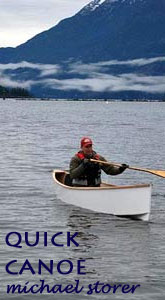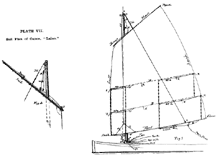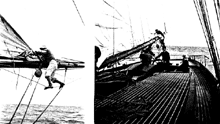
 Custom Search
|
| boat plans |
| canoe/kayak |
| electrical |
| epoxy/supplies |
| fasteners |
| gear |
| gift certificates |
| hardware |
| hatches/deckplates |
| media |
| paint/varnish |
| rope/line |
| rowing/sculling |
| sailmaking |
| sails |
| tools |
| join |
| home |
| indexes |
| classifieds |
| calendar |
| archives |
| about |
| links |
| Join Duckworks Get free newsletter CLICK HERE |
|
|
| Making Boat Handling Easier |
by Michael Storer – Adelaide, SA - Australia |
There are a number of things to make boat handling easier. As we all get more time on the water, see what other people are doing, share ideas on the internet we become better boat handlers and sailors. Like they say in competitive cycling ... "It's about the time in the saddle".
A good example of good tradition you can see the lug rig halyard arrangement I found In Dixon Kemp's 1850s manual. It overcomes the four points that Phil Bolger says are the only things holding back the balance lug from just about being perfect.
The method works extremely well for lug (and lateen which is the same rig essentially - a fully reefed balance lug becomes a lateen) of a trailerable size. It is not so good for long passages in bigger boats as chafe can be a problem. But no problems in years of small boat sailing. So I'm trying to show I'm a student of history but balanced by experience and study of the better aspects of modernity. You are all using spectra halyards on your lugsails aren't you :) Another place is centreboard size. You look at centreboards and leeboards from much earlier times and they are huge from Oyster raking sharpies to Dutch Boeir leeboards. You look at modern racing boats and they are deep. But something went wrong in many of the self build boat plans from the '50s and hasn't really been rectified yet. If you boat is a slouch upwind, put in a board a foot deeper and see what happens. Some classic boats can be enormously improved with a bit more board- properly shaped of course!. Joel White's Nutshell is one. My original prototype BETH sailing canoe was another. I had a board that projected about 2ft from the bottom of the hull and she was slow to tack, boring upwind - adding a foot to that utterly changed the boat. Suddenly I could sail boat for boat with a Laser in moderate conditions, the boat tacks faster, steers better. So that summarises my two major influences. History is far from bunk and racing boats are a great guide to what really works.
So now to a little bit of boat handling. Just a hint and a link to more details Chuck and I put on Duckworks. In the days of square riggers, reefing was done by tying in individual reef points along the length of the yartieds. A small team would work along. The reef knots would hold very nicely even in extreme conditions and helped pull the sail in bit by bit. They also distributed the loads along the spars. In modern boats, even our homemade ones, such a method might not strictly be necessary. Particularly if your boom is stiff enough to not bend in an exaggerated way normally. So here it is. Racing yachts rely on the main reefing lines at the front and back of the sail to do almost all the work. They often won't even put in the intermediate ties as the sail might well be unreefed again if the sail drops. The reason for tidying up the bunt of the sail is usually so it won't catch water or a wave in rougher conditions as something could break. I've often put the first reef in my BETH sailing canoe by tying the luff and leach reef lines down. IMPORTANT - tie the front one first and tie it as short as possible then the back on the principle that you need to pull the sail back to tension the foot and also loop from the reefing eye UNDER the boom to keep the reefing eye close to the boom and stop the boom from dropping down into the boat whenever you sheet on (or damaging the sail foot by overstretching it when you sheet on). So back to racing yachts and tying in intermediate reef points. So what do they use? The crew can't really come off the gunwale to tie in individual reef points they help keep the boat flat and fast. So they use a single long length of shockcord (bungee), have a loop in it that drops around one of the front fittings on the boom and it spirals its way going through each reef eyelet, then under the boom then on to the next reef eylet, under the boom and so on. Then the end is tied off at the rear end of the boom.
For more details we have documented it here. The page also includes a method for rolling a lug or gaff sail singlehandedly which leaves the boom fully exposed so that it can be attached to the boat before the sail is unrolled. |
To comment on Duckworks articles, please visit one of the following:
|
 |






